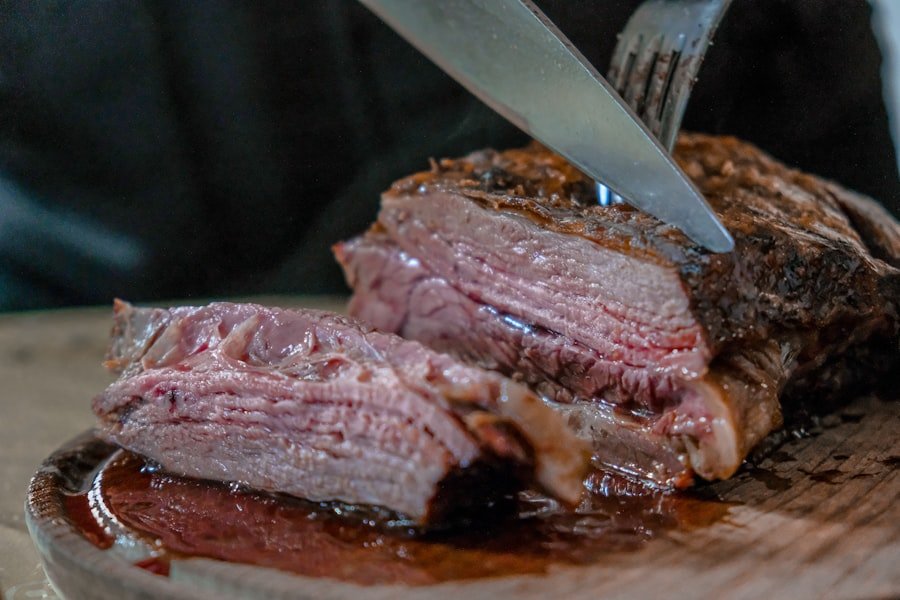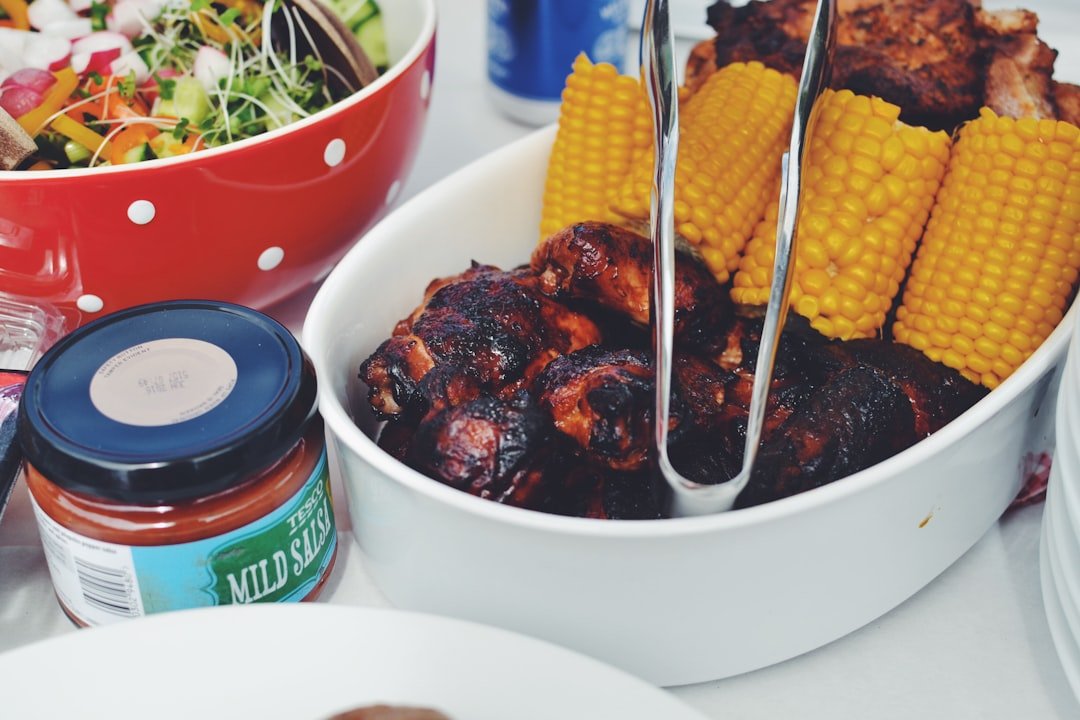When selecting ribs for grilling, several options are available. The two most common types are baby back ribs and spare ribs. Baby back ribs, also called back ribs or loin ribs, are shorter and more tender.
They are cut from the upper part of the rib cage near the spine and are characterized by their lean, meaty texture. Spare ribs are cut from the lower part of the rib cage, near the belly. They are larger and contain more fat than baby back ribs, with more connective tissue that makes them suitable for slow cooking methods like grilling.
When purchasing ribs for grilling, it is important to select cuts with ample meat and a balanced fat content. Look for ribs with a healthy pink color, avoiding any that appear discolored or have a slimy texture. Consider the number of people you will be serving when deciding on the quantity and type of ribs to buy.
Baby back ribs are smaller and may require more racks to feed a larger group, while spare ribs are larger and may require fewer racks for the same number of people. St. Louis-style ribs are another option, which are spare ribs trimmed into a rectangular shape.
These ribs are known for their meaty texture and are popular for grilling. Regardless of the type chosen, it is crucial to select fresh ribs that have been properly handled and stored to ensure the best quality for grilling.
Key Takeaways
- Choose ribs with good marbling and a pinkish color for the best flavor and tenderness
- Remove the membrane from the back of the ribs to ensure even cooking and better flavor absorption
- Season the ribs generously with a dry rub or marinate them for at least 4 hours to enhance the flavor
- Preheat the gas grill to medium heat and oil the grates to prevent sticking
- Grill the ribs over indirect heat for 1.5-2 hours, turning occasionally and basting with barbecue sauce
- Check for doneness by using a meat thermometer to ensure the internal temperature reaches 190°F
- Serve the ribs hot off the grill and enjoy with your favorite sides and sauces
Preparing the Ribs
Removing the Membrane
Before grilling your ribs, it’s essential to remove the membrane from the back of the ribs. This membrane can be tough and chewy when cooked, making it unpleasant to eat. To remove it, use a small knife to loosen one corner of the membrane, then grab it with a paper towel and pull it off in one piece.
Trimming Excess Fat
After removing the membrane, trim any excess fat from the ribs. While some fat is necessary for flavor and moisture, too much fat can cause flare-ups on the grill and lead to a greasy finished product. Use a sharp knife to carefully trim any large pieces of fat from the ribs, being careful not to remove too much meat in the process.
Final Preparation
Once the membrane has been removed and the fat has been trimmed, rinse the ribs under cold water and pat them dry with paper towels. This will help remove any bone fragments or debris from the ribs and ensure that they are clean and ready for seasoning. With your ribs now prepared, they are ready to be seasoned and marinated before grilling.
Seasoning and Marinating

Seasoning and marinating your ribs is an important step in ensuring that they are flavorful and tender when grilled. There are countless seasoning blends and marinades available, or you can create your own using a combination of herbs, spices, and other flavorings. A simple dry rub made with salt, pepper, garlic powder, onion powder, paprika, and brown sugar is a classic choice for seasoning ribs.
This blend of spices adds a balance of savory, sweet, and smoky flavors to the ribs. To apply the dry rub, generously coat both sides of the ribs with the seasoning blend, pressing it into the meat to ensure that it adheres. Once the ribs are seasoned, they can be wrapped in plastic wrap and refrigerated for several hours or overnight to allow the flavors to penetrate the meat.
This process not only adds flavor to the ribs but also helps tenderize them, resulting in a more juicy and flavorful finished product. In addition to dry rubs, marinades can also be used to add flavor to the ribs. Marinades typically consist of a combination of oil, acid (such as vinegar or citrus juice), herbs, spices, and other flavorings.
The ribs can be placed in a resealable plastic bag or shallow dish with the marinade and refrigerated for several hours or overnight. This allows the flavors to infuse into the meat and adds moisture to help prevent the ribs from drying out during grilling.
Preparing the Gas Grill
| Step | Time | Temperature |
|---|---|---|
| Cleaning the grill | 5 minutes | N/A |
| Preheating the grill | 10 minutes | Medium-high |
| Checking gas levels | 2 minutes | N/A |
Before grilling your seasoned and marinated ribs, it’s important to properly prepare your gas grill. Start by preheating your grill to a medium-low temperature, around 275-300°F. This will allow the ribs to cook slowly and evenly without burning or drying out.
If your grill has multiple burners, only light one or two of them to create an indirect cooking zone. This will help prevent flare-ups and allow the ribs to cook more gently. Once your grill is preheated, it’s important to clean the grates to ensure that your ribs don’t stick during cooking.
Use a grill brush to remove any debris or residue from the grates, then use a paper towel or cloth dipped in oil to lightly grease the grates. This will help prevent sticking and ensure that your ribs have beautiful grill marks when they are finished cooking. In addition to cleaning and greasing the grates, it’s important to have all of your grilling tools and supplies ready before you start cooking.
This includes long-handled tongs for flipping the ribs, a meat thermometer to check for doneness, and a basting brush if you plan on applying barbecue sauce during cooking. Having everything prepared ahead of time will make the grilling process go smoothly and ensure that your ribs turn out perfectly.
Grilling the Ribs
Once your gas grill is preheated and prepared, it’s time to start grilling your seasoned and marinated ribs. Place the ribs on the grill over indirect heat, bone-side down, and close the lid. Let the ribs cook for about 1 ½ – 2 hours, depending on their size and thickness.
It’s important to resist the temptation to constantly check on the ribs or flip them too often, as this can cause heat loss and result in uneven cooking. After about 1 ½ hours of cooking, you can check on the ribs to see how they are progressing. Use long-handled tongs to carefully lift one end of the rack and look for browning on the meat side.
If the meat is starting to brown and pull away from the bones, it’s time to flip the ribs over and continue cooking them on the meat side. Once you have flipped the ribs over, you can brush them with barbecue sauce if desired. This adds a sweet and tangy flavor to the ribs and helps create a caramelized glaze as they finish cooking.
Be sure to brush the sauce on during the last 15-20 minutes of cooking to prevent burning or charring.
Checking for Doneness

Using a Meat Thermometer
After about 2 hours of cooking, it’s essential to check your ribs for doneness before removing them from the grill. The most accurate way to do this is by using a meat thermometer inserted between two bones in the thickest part of the rack. The internal temperature should read at least 190°F for tender, fall-off-the-bone ribs.
Visual Inspection
In addition to using a meat thermometer, you can also check for doneness by visually inspecting the ribs. The meat should be tender and pull away easily from the bones when they are finished cooking. If you prefer your ribs with a bit more chew, you can cook them until they reach an internal temperature of 180°F.
Serving and Resting
Once your ribs are done cooking, carefully remove them from the grill using long-handled tongs and transfer them to a cutting board or serving platter. Let them rest for a few minutes before cutting into individual portions.
Serving and Enjoying the Ribs
After your perfectly grilled ribs have rested for a few minutes, it’s time to serve them up and enjoy! You can cut the rack into individual portions using a sharp knife or simply serve them whole for a rustic presentation. Ribs pair well with a variety of side dishes such as coleslaw, potato salad, cornbread, or grilled vegetables.
You can also serve them with additional barbecue sauce on the side for dipping or drizzling. When it comes to enjoying your grilled ribs, be sure to have plenty of napkins on hand as they can be messy! The tender meat should pull easily away from the bones with each bite, leaving you with a mouthwatering combination of smoky flavor and savory goodness.
Whether you’re hosting a backyard barbecue or simply craving some delicious grilled ribs, following these steps will ensure that you end up with perfectly cooked and flavorful ribs every time. So fire up your gas grill, grab some racks of your favorite type of ribs, and get ready to impress your friends and family with your newfound grilling skills!
If you’re looking for more tips and tricks for grilling, be sure to check out Grilloffers.com. They have a great article on how to set up a rough terrain kit for your gas grill, which can be really helpful for getting the perfect BBQ ribs. You can find the article here.

